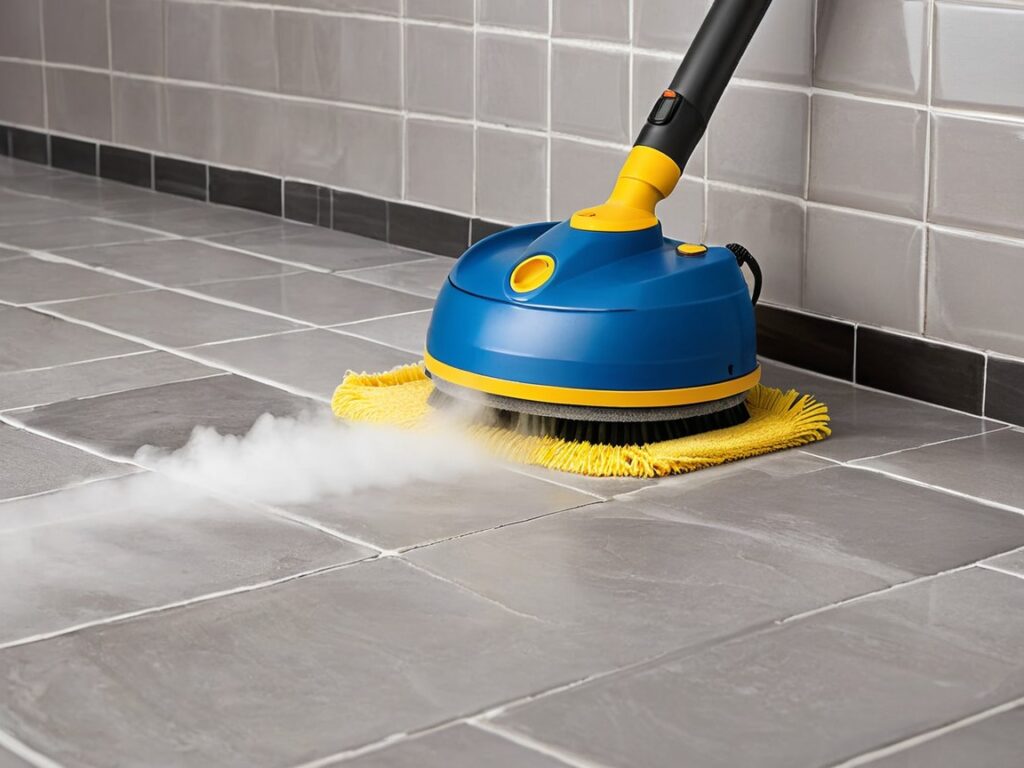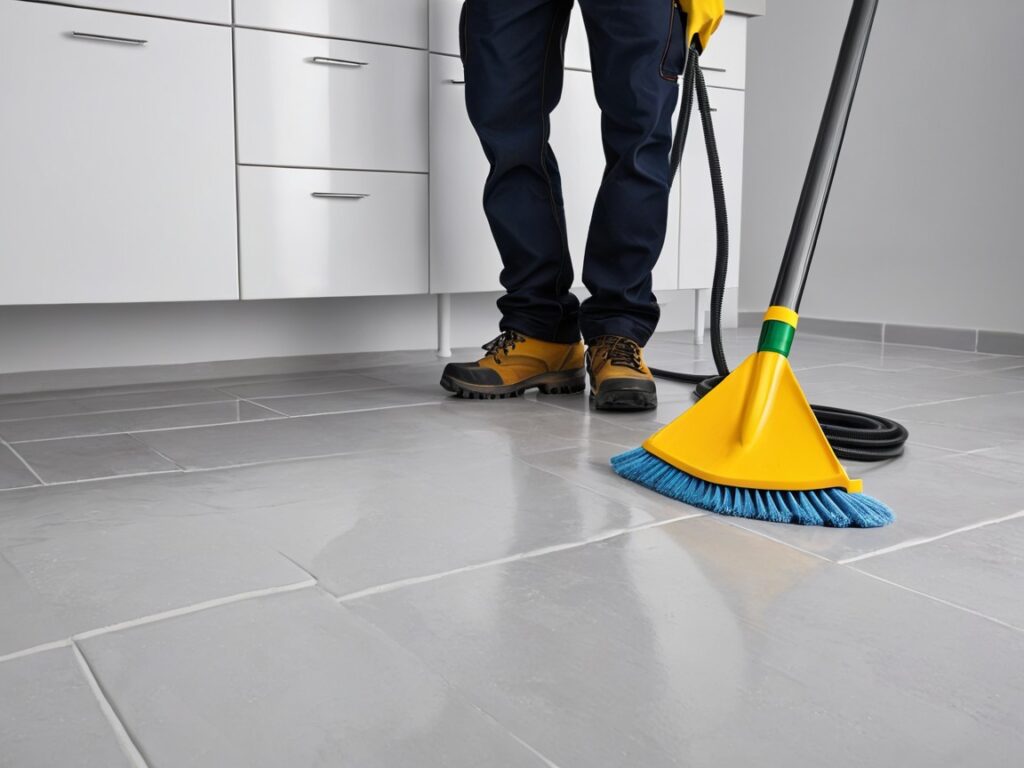
Introduction:
Cleaning tile grout with a steam cleaner is one of the most effective ways to restore the shine and freshness of your tiled surfaces. Over time, grout can collect dirt, soap scum, and mildew, making your floors or walls look dull and aged. A steam cleaner uses high-temperature steam to loosen grime and kill bacteria—without the need for harsh chemicals. In this guide, we’ll answer the most common questions about using a steam cleaner to make your grout look spotless again.
Table of Contents
Why Cleaning Tile Grout Matters
Cleaning tile grout is an essential part of maintaining the beauty and hygiene of your tiled surfaces. Over time, grout lines collect dirt, soap residue, moisture, and even mold, which can make your tiles look old and unattractive. Regular cleaning tile grout not only improves appearance but also extends the life of your tiles and keeps your home healthier.
When grout becomes dirty, it can trap bacteria and allergens, especially in bathrooms and kitchens where moisture is common. This buildup not only causes unpleasant odors but can also lead to stains that are difficult to remove later. By cleaning tile grout regularly, you prevent this grime from setting in and protect your surfaces from long-term damage.
Another key reason why cleaning tile grout matters is to maintain the integrity of the grout itself. Dirt and mold can weaken grout, causing cracks or deterioration, which might eventually require regrouting. Keeping grout clean helps preserve its strength and keeps tiles firmly in place.
Overall, cleaning tile grout ensures your space remains fresh, clean, and visually appealing. It’s a small maintenance task that makes a big difference in both cleanliness and durability.
1. Prevents Mold and Mildew Growth
Grout is porous, which means it easily absorbs moisture. In damp areas like bathrooms or kitchens, this creates the perfect environment for mold and mildew to grow. Using a steam cleaner helps sanitize grout deeply, killing bacteria and spores without the need for harsh chemicals.
2. Maintains a Clean and Fresh Look
Dirty grout can make even the cleanest tiles appear dingy or stained. Regular cleaning restores the grout’s original color and brightens the entire room. When you know how to clean tile grout with steam cleaner, you can easily maintain that fresh, just-installed look with minimal effort.
3. Protects Tile Longevity
Neglecting grout cleaning can lead to long-term damage. Dirt and grime trapped in grout lines can weaken the bond between tiles, causing cracks or loosening. Steam cleaning removes buildup without harsh scrubbing, helping your tiles last longer and saving on costly repairs.
4. Improves Hygiene and Air Quality
Grout can harbor bacteria, allergens, and mold spores, which may affect indoor air quality and health. A steam cleaner not only removes visible dirt but also sanitizes surfaces naturally with high-temperature steam—making your home cleaner and safer.
Benefits of Using a Steam Cleaner for Grout
If you’ve ever spent hours scrubbing grout with brushes and chemical cleaners, you’ll appreciate how efficient and eco-friendly it is to learn how to clean tile grout with steam cleaner. Steam cleaning is one of the most effective ways to remove dirt, stains, and bacteria—without damaging tiles or using harsh products. Below are the key benefits that make it a smart choice for both homes and commercial spaces.
1. Deep Cleans Without Chemicals
Steam cleaning uses only water, heated to a high temperature, to loosen and dissolve grime deep within the grout. This means you can achieve a spotless finish without using toxic or abrasive cleaners. It’s an ideal method for households with children, pets, or allergy sufferers.
2. Kills Germs, Mold, and Bacteria
The high temperature of steam naturally sanitizes surfaces by killing bacteria, mold, and mildew spores. When you understand how to clean tile grout with steam cleaner, you’re not just removing visible dirt—you’re also improving hygiene and preventing mold growth in humid areas like bathrooms or kitchens.
3. Saves Time and Effort
Traditional grout cleaning can be physically demanding and time-consuming. A steam cleaner simplifies the process by loosening dirt quickly, making it easier to wipe away residue. You’ll clean large areas more efficiently, saving both time and energy.
4. Restores Original Grout Color
Over time, grout tends to darken due to embedded dirt and soap scum. Steam cleaning lifts away this buildup, restoring the original colour and brightness of your tiles. The result is a cleaner, newer-looking floor or wall without the need for re grouting.
5. Eco-Friendly and Cost-Effective
Since steam cleaning only requires water, it’s both environmentally friendly and budget-friendly. You’ll reduce plastic waste from cleaning products and avoid exposure to harsh fumes while saving money on supplies in the long run.
By understanding how to clean tile grout with steam cleaner, you can achieve a deep, chemical-free clean that enhances your home’s hygiene, protects your tiles, and benefits the environment—all in one step.
Step-by-Step Guide: How to Clean Tile Grout with Steam Cleaner
Learning how to clean tile grout with steam cleaner is easier than you might think. This method is powerful, eco-friendly, and eliminates the need for harsh scrubbing or chemical cleaners. Follow these simple steps to get professional-quality results at home.
Prepare the Area
Before starting, sweep or vacuum the tiled surface to remove dust and loose debris. This ensures the steam can penetrate the grout effectively without pushing dirt deeper.
Fill and Heat the Steam Cleaner
Pour clean water into your steam cleaner’s tank, following the manufacturer’s instructions. Allow it to heat until it reaches the proper temperature for steam generation (usually a few minutes).
Attach the Grout Cleaning Brush or Nozzle
Use the narrow nozzle or small brush attachment designed for grout cleaning. These tools help focus the steam on grout lines for more precise and effective cleaning.
Start Cleaning the Grout Lines
Hold the steam cleaner a few inches from the grout and slowly move it along each line. The steam will loosen dirt, grime, and mild instantly. For heavily stained areas, pause for a few seconds to let the steam penetrate deeper.
Scrub Lightly (If Needed)
If any dirt remains, use a small brush or toothbrush to scrub the grout gently while it’s still damp. The loosened grime should wipe away easily with minimal effort.
Wipe Away Residue
After steaming, use a clean microfiber cloth or mop to wipe away moisture and dirt. This prevents residue from drying back into the grout lines.
Let the Area Dry
Allow the cleaned tiles and grout to air dry completely before using the space again. Proper drying prevents mold or mildew from returning.
Pro Tip:
For stubborn stains, you can apply a mixture of baking soda and water to the grout before steaming. The combination of natural cleaning and high-temperature steam delivers an even deeper clean.
Mistakes You Should Avoid When Using a Steam Cleaner
Knowing how to clean tile grout with steam cleaner properly can make a big differeMISnce in your results. However, many people unknowingly make mistakes that reduce cleaning efficiency—or even damage their tiles and grout. Avoid these common errors to ensure your grout stays clean, bright, and intact.
1. Skipping Pre-Cleaning
One of the biggest mistakes is using a steam cleaner on dirty floors without removing loose debris first. Dust and grit can turn into muddy residue once steam is applied.
Tip: Always sweep or vacuum your tiles before using the steam cleaner.
2. Not Allowing the Steam Cleaner to Heat Properly
Steam that isn’t hot enough won’t break down grime effectively. Starting too early leads to uneven cleaning and wasted effort.
Tip: Wait until the steam cleaner fully heats up before beginning your cleaning session.
3. Using the Wrong Attachment
Each steam cleaner comes with different nozzles or brushes. Using a large brush on narrow grout lines won’t clean effectively and can leave streaks behind.
Tip: Use the small grout nozzle or brush attachment specifically designed for tight grout lines.
4. Overusing Steam in One Spot
Holding the steam in one area for too long can cause grout to loosen or crack, especially on older tiles.
Tip: Move the steam cleaner slowly and evenly across grout lines instead of concentrating on one spot.
5. Ignoring Post-Cleaning Care
After steaming, some people skip wiping away moisture or residue. This mistake can allow dirt and minerals to settle back into the grout.
Tip: Always wipe the surface with a clean microfiber cloth after steam cleaning to keep grout spotless.
6. Using Steam on Unsealed or Damaged Grout
Applying steam to cracked or unsealed grout can cause water penetration, leading to mold or mildew growth later.
Tip: Check your grout’s condition before cleaning. Reseal it if necessary to protect against moisture.
By avoiding these common mistakes, you’ll get the best possible results when learning how to clean tile grout with steam cleaner. With proper technique, your tiles will shine, and your grout will look fresh and renewed—without damage or residue.
Maintenance Tips to Keep Grout Clean Longer
After you’ve mastered how to clean tile grout with steam cleaner, the next step is maintaining that spotless look. Regular upkeep prevents dirt, mold, and soap scum from building up again. Here are some simple but effective maintenance tips to help your grout stay cleaner for longer.
1. Wipe Down Tiles After Each Use
Moisture and soap residue are the biggest causes of grout discoloration. After using your bathroom or kitchen, quickly wipe tiles and grout with a dry microfiber cloth.
Tip: A 30-second wipe-down can prevent weeks of deep cleaning later.
2. Use a Mild Natural Cleaner Weekly
Even with steam cleaning, a gentle weekly clean helps maintain results. Use a mix of equal parts white vinegar and water in a spray bottle to keep grout fresh.
Tip: Avoid harsh chemicals—they can wear down grout sealant over time.
3. Keep Grout Sealed
Unsealed grout absorbs dirt and moisture quickly. Resealing grout every 6–12 months adds a protective barrier that keeps stains and mold away.
Tip: Choose a high-quality grout sealer for the best long-term protection.
4. Improve Air Circulation
In bathrooms, trapped moisture encourages mold growth. Turn on an exhaust fan or open a window after showers to help grout dry faster.
Tip: Keep humidity below 50% to prevent mildew.
5. Spot Clean Stains Immediately
Don’t let spills or stains sit for too long. A quick wipe with a natural cleaner or mild detergent keeps grout looking new.
Tip: Regular spot cleaning reduces the need for frequent deep cleaning.
6. Steam Clean Periodically
Even with good daily habits, steam cleaning every few months keeps grout thoroughly sanitized and bright. It’s one of the most effective and eco-friendly ways to maintain your tiles.
Tip: Focus on high-traffic or high-moisture areas more often, like the shower or kitchen floor.

By following these simple habits, you’ll keep your grout clean and fresh long after learning how to clean tile grout with steam cleaner. Consistent maintenance not only saves time but also preserves the look and longevity of your tiles.
FAQs About Cleaning Tile Grout with a Steam Cleaner
Can a Steam Cleaner Really Clean Tile Grout Effectively?
Yes, a steam cleaner is excellent for cleaning tile grout. The high-temperature steam penetrates deep into the grout lines, loosening dirt, mold, and soap scum. With the right nozzle and consistent motion, your grout will look refreshed without the need for scrubbing.
Do I Need to Use Any Cleaning Solutions with a Steam Cleaner?
In most cases, no. Steam alone is powerful enough for cleaning tile grout. However, for heavily stained grout, you can pre-treat the area with a mild baking soda and water paste before steaming. Avoid harsh chemicals—they can damage both the tiles and the grout.
Is Steam Cleaning Safe for All Types of Tiles?
Steam cleaning is generally safe for ceramic and porcelain tiles. However, it’s best to avoid using it on unsealed natural stone tiles like marble or limestone, as the moisture can seep in and cause discoloration. Always check your tile manufacturer’s care recommendations.
How Often Should I Steam Clean My Grout?
For regular maintenance, cleaning tile grout once every one to two months is sufficient. In high-traffic areas like bathrooms and kitchens, monthly cleaning can prevent grime buildup and maintain a bright appearance.
Can Steam Cleaning Remove Mold and Mildew?
Yes! Steam cleaners can reach temperatures above 200°F (93°C), effectively killing mold spores and bacteria hiding in grout lines. This makes steam cleaning a great choice for households aiming to keep their bathroom and kitchen hygien
Do I Need to Seal the Grout After Steam Cleaning?
Absolutely. Once the grout is clean and dry, applying a grout sealer helps protect it from future stains and moisture damage. This step extends the life of your grout and keeps it looking fresh for longer.
Conclusion:
Keeping your tile grout clean doesn’t have to be a constant struggle. Using a steam cleaner is an effective, eco-friendly, and time-saving way to restore your grout’s original shine without harsh chemicals. Regular steam cleaning not only removes stubborn stains and buildup but also helps maintain a healthier environment by eliminating germs and mold.
By following proper cleaning techniques and consistent maintenance, you can keep your tiles and grout looking fresh for years to come. Investing in a quality steam cleaner and using it periodically is truly the key to a spotless, sparkling bathroom or kitchen.
